The UK housing stock is among the least energy-efficient in Europe, with over half of the properties having an energy rating of D or below. This signals a vast opportunity for improvement in the sector.
Proper insulation not only enhances energy efficiency and reduces heating costs but also improves the comfort of living spaces and lowers health risks caused by frequent indoor temperature fluctuations. With stable energy prices, these improvements can lead to significantly lower energy bills.
The UK government has introduced various schemes to support lower-income households and encourage the transition from fossil fuel heating systems to sustainable alternatives like heat pumps. However, progress in retrofitting existing buildings remains slow. One of the key barriers to adoption is the low financial efficiency of home improvements, as payback periods can stretch over decades. Additionally, government research suggests there is no strong statistical link between improved energy ratings and increased property values.
The Standard Assessment Procedure currently used to provide energy rating to the properties is being revised and new the home energy model is going to be introduced in 2025.
Despite these challenges, the government continues to push for progress. Several organizations are promoting the need for building fabric improvements, including the Sustainable Energy Authority of Ireland, Energy Savings Trust, Home Energy Scotland, and commercial providers like Furbnow, Ecofurb, and Snugg. Furthermore, new-build properties are increasingly being constructed to meet higher energy efficiency standards.
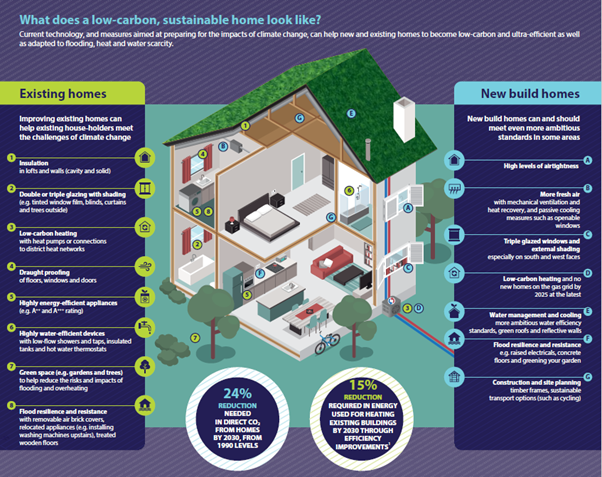
The Home Efficiency Challenge in the UK
Real estate is and has been one of the best investments providing secure income for many generations of investors. Nevertheless, it is the industry which due to its lifetime has a lot of heritage which must be rediscover itself.
Dwellings in the UK is the leakiest in Europe according to Tado:
UK Homes among worst insulated in Europe. Average home heat loss after five hours in 2020.
Source: (BBC, 2022)
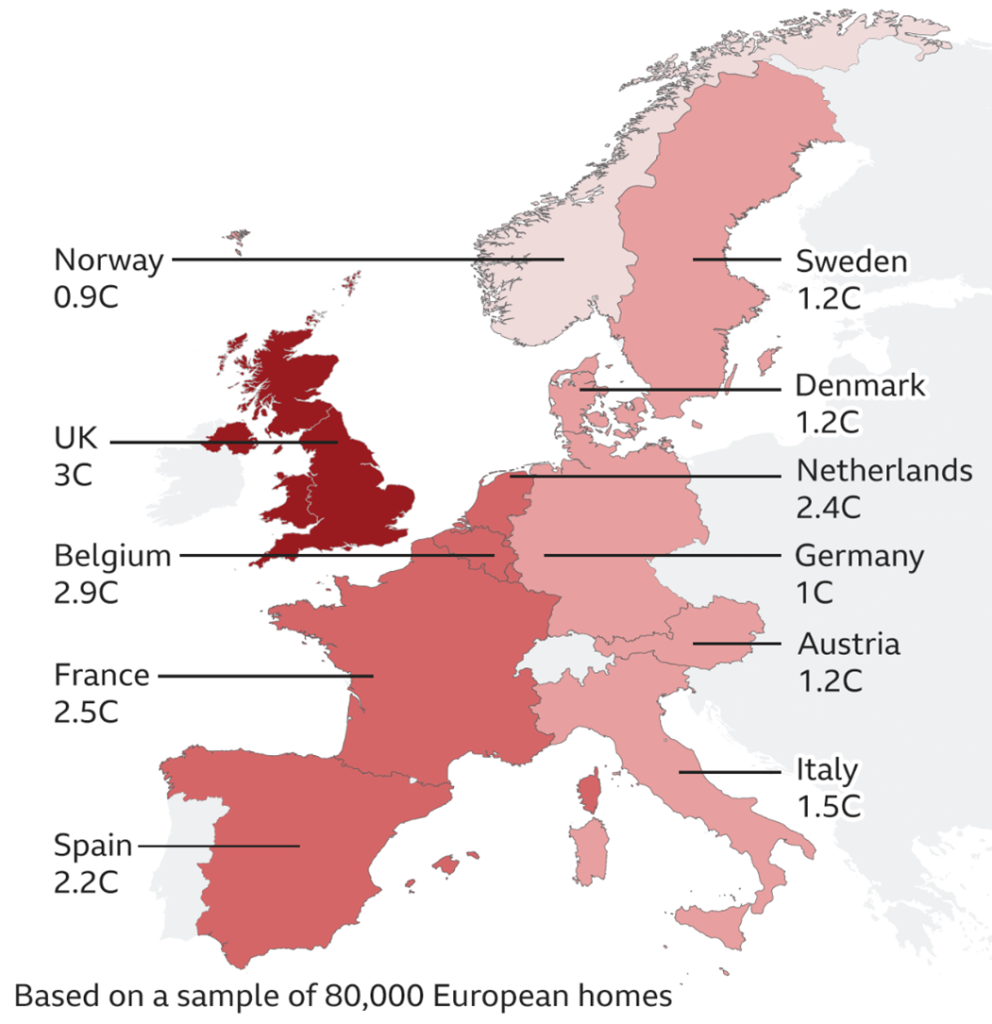
The most recent data from ONS (2023) shows that 57% of residential dwellings in England and Wales have EPC rating lower than C. And only 12% have rating B.
Domestic Properties in England and Wales by Energy Efficiency Rating – in each Year/Quarter to 30 September 2024.
Source: ONS, 2024
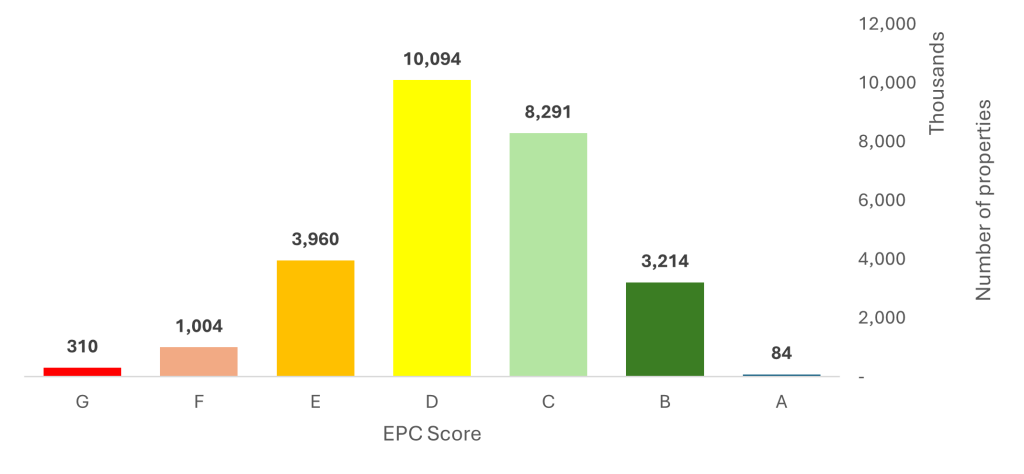
According to English housing survey, 20% of houses in England was built before 1920 (Designing Buildings, 2020), which is approximately 4.5 mln dwellings. Also, only 49% of dwellings has walls properly insulated, and only 39% percent insulate its attic/loft space. Bad insulation is compensated with heating premises in order to keep some acceptable level of comfort; however, it has poor outcome with contemporary energy saving trends. Currently, home heating is liable for 16% of the UK CO2 emissions (Department for BEIS, 2023). Therefore, UK government has an initiative to reduce those emissions by accelerating rate of insulation for British homes (PWC, 2023).
UK government identify increasing property energy efficiency as important measure to reduce the UK’s carbon emissions, as well as energy bills for consumers (Scott, E, 2024).
Committee on Climate Change (CCC) has defined the following areas which need urgent changes (CCC, 2019):
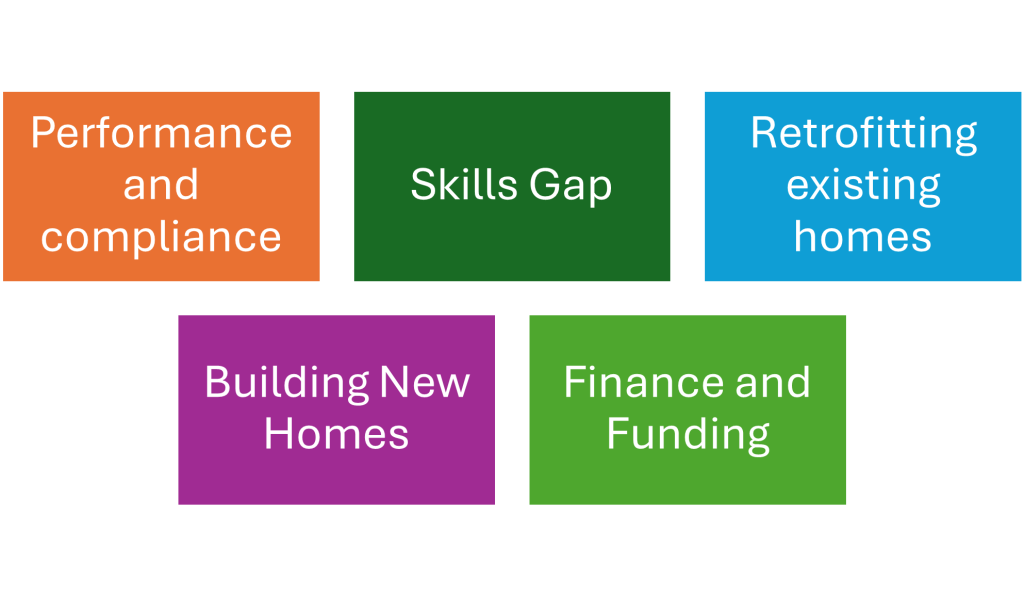
Here we are going to focus on existing homes, which are apparently more difficult to upgrader and / or retrofit.
Insulation Needs
Insulation needs vary, but it is estimated that 13.3 million households need loft insulation, 5.9 million need cavity wall insulation and 7.4 million need solid wall insulation (WHICH?, 2022).
As a result, many buildings in the UK have a lot of potential of improving its energy rating.
London has the lowest rating for both roof and wall insulation according to ONS (2022). London is followed by Leeds, Manchester, and Cardiff. In their research ONS has identified, that the homes with better wall insulation have better general EPC (Energy Performance Certificate) score (Energy Saving Trust, 2024): dwellings with “very good” wall insulation achieved and EPC C or above in 98% in England and 97% in Wales. Such insulation has more impact for houses rather than for flats.
Mapping wall insulation in the UK.
Source: ONS, 2023
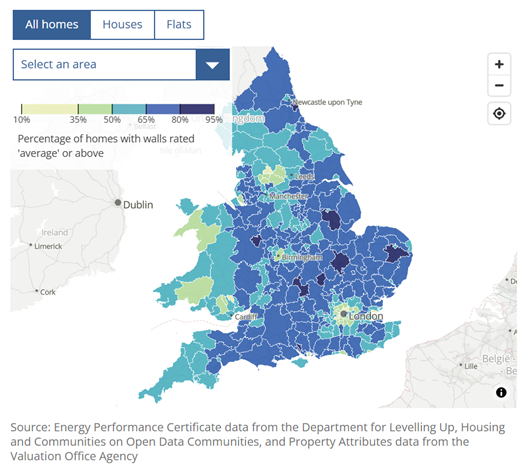
Action to be Taken
To improve the situation, CCC report offers the following steps to low-carbon home (CCC, 2019):
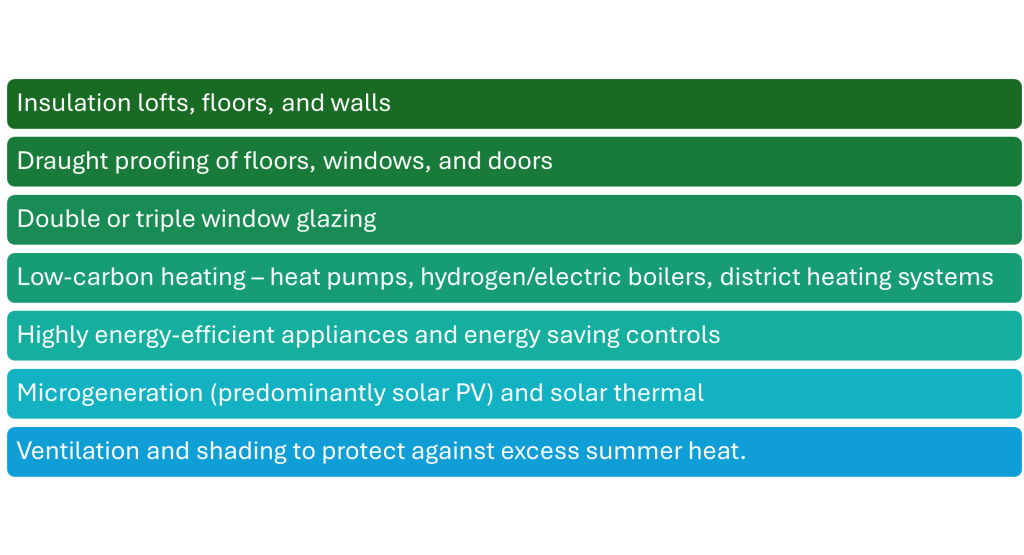
There are two ways of retrofitting: “shallow” and “deep”. Shallow retrofit involves simple measures such as floor and loft insulation, while deep retrofit also involves more pervasive measures such as insulating solid walls, triple glazing, and replacing gas boilers with heat pumps.
Benefits of Improving Insulation
Financial Benefits
There are certain benefits of improved insulations. There are some obvious one, such as improved comfort of living, as well as some contradictionary such as financial gains.
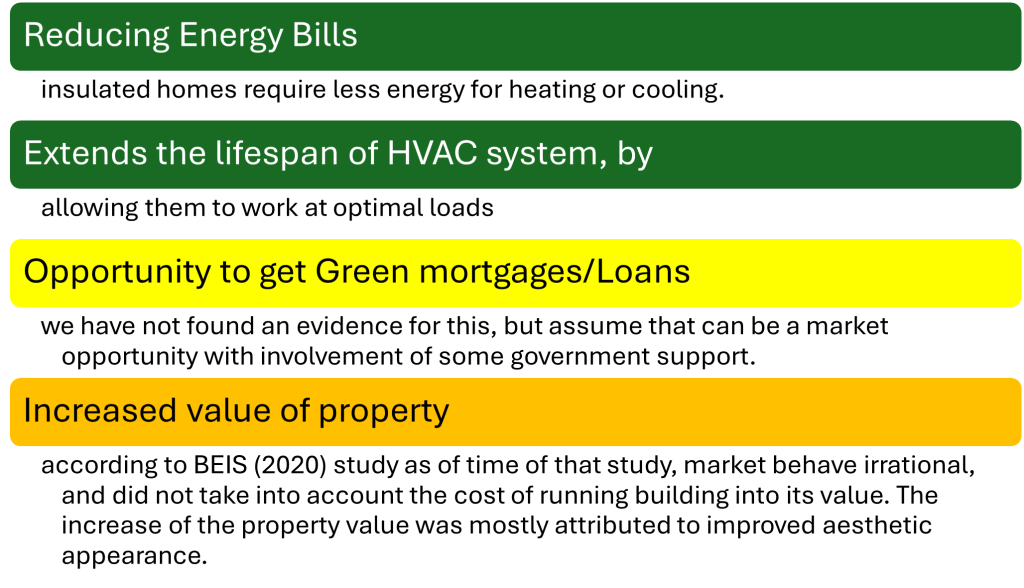
Improving Comfort

Positive impact on the climate
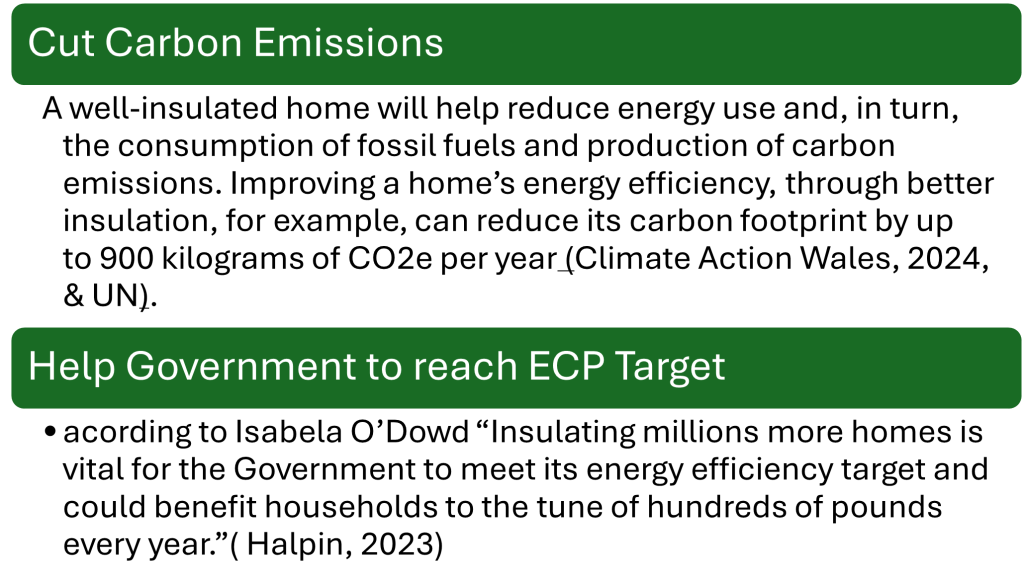
Consumers Actions
According to PWC report, retrofit of existing houses is a key for decarbonisation but low at adoption. Retrofit is a first step to increase the building energy efficiency which then is followed by change of the heat source, e.g. heat pump.
Which? (2023) has done research on how to empower homeowners to proceed with insulation of their property. According to Which? Only 37% of UK homeowners look at the first step in insulation of their property, and only on third of those proceed with insulation.
When which? Asked why the people do not insulate their properties, often the concern was about the first steps in the process. People struggle with identifying which insulation is needed, which company can do the work, and how to fund the project.
According to their research, only half of the respondents were concerned about the costs of payback period, and only 10% were not able to find trustable traders to perform the job.
Such conclusion is supported by PWC findings (2023). PWC found misalignment between the expected [social] benefits and the costs to be taken by private owners:
- Retrofit have large upfront costs (£6000 for “shallow” and £50 000 for deep retrofit for average house)
- Financial returns are slow and uncertain – with payback period of around 10-15 years
- There is not a strong narrative for retrofitting. Perceptions also prevent homeowners from undertaking a deep retrofitting.
Furthermore, the House of Lords (Scott, 2024) supported that with the findings of Social Market Foundation, stating that people are concerned about costs, and a quarter of them saying they could not afford it.
Another big problem for the wider rollout of home retrofitting PWC names the shortage of skilled labour. Annual jobs to be supported by retrofitting market is from c.71 000 to c.584 000, from shallow to deep retrofitting respectively (PWC, 2023).
Certification System: Current and It’s Future Development
Standard Assessment Procedure (SAP) for energy rating of the dwellings – is a current methodology used to estimate the energy performance of homes.
There are two main uses for it:
- To demonstrate compliance of new homes with Part L of Building Regulations;
- To generate Energy Performance Certificates (EPC) for all homes, which advise occupants, prospective buyers, landlords, and renter of the energy performance of property (DESNZ, 2023).
Despite the longevity of SAP use, it has some shortcomings described in CCC (2019) report:
“There are a number of areas where SAP currently fails to properly value the benefits of low-carbon technologies.
The first is in relation to emission factors for electricity. SAP calculates the energy and carbon implications of a building component by using a single emissions factor for each fuel. These emission factors reflect the average carbon intensity forecast over a 3-5 year period following the SAP update – for SAP 2012 the electricity carbon intensity was set at 0.519 kgCO2 per kWh and this carbon intensity remains the basis of SAP calculations today” (CCC, 2019, p55).
“Since the EPC rating is cost-based, it is more suited to issues around fuel poverty rather than energy efficiency improvements or emission savings. It is subject to fuel price variations over time and can lead to perverse incentives where emission saving measures involve a switch in fuels” (CCC, 2019, p 117).
Future development
The UK Government currently working on replacing the Standard assessment procedure (SAP) with a new system (Bolton, 2024) .
The government is currently developing the home energy model (HEM) (DESNZ, 2024), a new methodology for assessing the energy efficiency of homes that is intended to replace the SAP. This followed criticism of the SAP by the CCC which argued the existing methodology could be distorted by changes in energy costs and undervalues the benefits of low-carbon technologies. The consultation on the HEM was launched in December 2023. The government intention is to have HEM to be more accurate and robust than the SAP. According to the government, the HEM would be introduced in 2025” (Scott, E 2024)
Government Initiatives
| Name of the Scheme | Description | Provider |
|---|---|---|
| Home Upgrade Grant | The Home Upgrade Grant (HUG) provides energy efficiency measures and low carbon heating to low income households living in the worst performing, off gas grid homes in England to tackle fuel poverty and make progress towards net zero 2050. | Support through installers |
| Boiler Upgrade Scheme | The Boiler Upgrade Scheme provides grants to property owners to install low carbon heating systems such as heat pumps. | Support through local authority |
| Sustainable Warmth Competition | The Sustainable Warmth Competition awards funding to local authorities to help them upgrade energy inefficient homes of low-income households in England, which are either heated by mains gas or are off the gas grid. | Support through local authority |
| Social Housing Decarbonisation Fund | The Social Housing Decarbonisation Fund will upgrade a significant amount of the social housing stock currently below EPC D up to that standard. | Support through local authority |
| Energy Company Obligation ECO4 and ECO4 Flex | The Energy Company Obligation (ECO) is a requirement for energy suppliers to help households reduce the costs of their home heating by fitting energy-saving measures. Different energy suppliers have different amounts of support and offer different types of improvements – so you will need to check with your energy company if you’re eligible. | Support through the energy company |
| Great British Insulation Scheme | The Great British Insulation Scheme is a government scheme to help people insulate their homes, make them more energy efficient and save money on their energy bills. | |
| Warm Homes: Local Grant | a government-funded scheme delivered by Local Authorities […]. It will provide grants for energy performance upgrades and low carbon heating to low-income households living in the worst quality, privately owned homes in England to achieve energy bill savings and carbon savings. These upgrades will be open to all fuel types, including on gas households, and off gas households (those heated by electricity, oil, coal, or liquid petroleum gas). (DESNZ, B, 2024) | Support through local authority |
Source: Gov.UK, 2023
Ecosystem of Retrofitting Promoters
Example of organisations which provide and advice and support regarding insulation (ONS, 2023):
| Organisation | Description / About |
|---|---|
Sustainable Energy Authority of Ireland | SEAI is Ireland’s national sustainable energy authority. We work with householders, businesses, communities and government to create a cleaner energy future. |
 Energy Savings Trust | is an independent organisation – working to address the climate emergency. A respected and trusted voice on energy efficiency and clean energy solutions, we continue to work towards a smart, decarbonised, decentralised energy system. We empower millions of householders every year to make better energy choices. We deliver transformative energy programmes working with governments. We support businesses with energy efficiency strategies, research, assurance and communications, enabling them to play their part in building a sustainable future. |
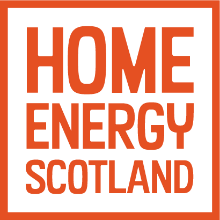 Home Energy Scotland | At Home Energy Scotland we’re here to offer free advice and support to help you make your home warmer, reduce energy bills, and contribute to a greener, more sustainable future. Our service is funded by the Scottish Government and managed by Energy Saving Trust. We are committed to positively impacting the lives of people throughout Scotland. Our primary focus is tackling fuel poverty and the climate emergency, by helping people stay warmer at home for less and reducing their carbon footprint; all critical priorities for the Scottish Government. |
FURBNOW | Our mission is to decarbonise millions of UK homes – via a simple process that guarantees quality. We do this by providing trusted, impartial, and actionable advice to carry out the work your home actually needs. As your independent expert, we’re ready to help upgrade your home to be warm and environmentally-friendly. |
ECOFURB | We believe the upfront cost of energy efficiency should not be a barrier to benefiting from long-term savings and a healthier home with lower carbon emissions. We help our customers access available grants and finance by: assessing grant eligibility; connecting you to free and impartial financial advice and meeting the standards required by ‘green finance’ – mortgages and loans specifically provided for energy efficiency home improvements. |
SNUGG | At Snugg, we believe that making your home energy efficient should be simple and affordable. But too many people find the process of researching and improving their home’s efficiency to be complicated and expensive. That’s why we’re building an easy-to-use online platform that does the hard work for you. |
To summarise, the UK faces a significant challenge with the energy efficiency of its housing stock. While this problem has been recognised for decades, efforts by the government to address it have been hindered by the substantial financial costs involved in implementing widespread solutions.
Although improving energy efficiency offers numerous benefits, including lower energy bills, better living conditions, and reduced carbon emissions, the lack of robust economic incentives has left property owners without strong financial motivation to upgrade their homes. This, in turn, limits private investment in the home retrofitting sector.
The resulting low demand for retrofitting services has also made the industry less attractive to skilled workers, creating a cycle that further hampers progress.
Nevertheless, the UK government continues to provide regulations and financial support to tackle this issue. Several non-profit and for-profit organisations are actively raising awareness and offering practical solutions to address the energy efficiency gap.
Additionally, the existing energy efficiency system is undergoing a transition to a new approach, the outcomes of which remain to be seen. This shift could potentially reshape the landscape and drive further progress in improving the UK’s housing energy efficiency.
References:
BBC (2022) “Home insulation: How can it cut energy bills?”, 28 November, accessed on 2 Dec 2024, https://www.bbc.co.uk/news/explainers-60289396
BEIS (2020) “The impact of solid wall insulation on property value” , https://assets.publishing.service.gov.uk/government/uploads/system/uploads/attachment_data/file/913512/impact-solid-wall-insulation-property-value.pdf
Bolton P (2024) “Energy Efficiency of UK Homes”, Research Briefing, House of Commons, 11 December https://researchbriefings.files.parliament.uk/documents/CBP-9889/CBP-9889.pdf
CCC (2019) UK Housing: Fit for the Future? https://www.theccc.org.uk/wp-content/uploads/2019/02/UK-housing-Fit-for-the-future-CCC-2019.pdf
Climate Action Wales (2024), Insulating Your Home, https://www.climateaction.gov.wales/green-energy-choices/insulation/
Department for BEIS (2023), UK Greenhouse gas emissions, accessed on 2 Dec 2024 https://assets.publishing.service.gov.uk/government/uploads/system/uploads/attachment_data/file/1134664/greenhouse-gas-emissions-statistical-release-2021.pdf
Designing Buildings (2020), “English housing stock age”, 22 Oct, https://www.designingbuildings.co.uk/wiki/English_housing_stock_age
DESNZ (2023) «Standard Assessment Procedure», https://www.gov.uk/guidance/standard-assessment-procedure
DESNZ, A (2024) , Home Energy Model: replacement for the Standard Assessment Procedure (SAP), https://www.gov.uk/government/consultations/home-energy-model-replacement-for-the-standard-assessment-procedure-sap
DESNZ, B (2024) Warm Homes: Local Grant, https://assets.publishing.service.gov.uk/media/66f1573cbd3aced9da489bcf/Warm-Homes-Local-Grant-guidance.pdf
EDF (2018), “Why should I insulated my home”, https://www.edfenergy.com/energywise/why-should-I-insulate-my-home
Energy Saving Trust (2024). “EPC Explained”., 18 September, https://energysavingtrust.org.uk/advice/guide-to-energy-performance-certificates-epcs/
GOV.UK (2023), “Find energy grants for your home (Help to Heat)”, 23 March, https://www.gov.uk/government/collections/find-energy-grants-for-you-home-help-to-heat
Halpin, D (2023) “‘Substantial gap’ between Government insulation targets and delivery”, Independent, 26 June, https://www.independent.co.uk/climate-change/news/uk-government-government-house-of-lords-england-b2363984.html
Home Insulation Installers, “10 Benefits of Home Insulation You Should Know”, https://homeinsulationinstallers.co.uk/10-benefits-of-home-insulation-you-should-know
Insulation Direct (2024) “The Benefits of Better Insulation in UK Homes: A Comprehensive Guide”, https://insulation-direct.co.uk/post/the-benefits-of-better-insulation-in-uk-homes-a-comprehensive-guide
Office for National Statistics, (ONS, 2024), “Table D1: Domestic Energy Performance Certificates for all dwellings by energy efficiency rating”, released 24 October 2024, ONS website, https://www.gov.uk/government/statistical-data-sets/live-tables-on-energy-performance-of-buildings-certificates
Office for National Statistics, (ONS, 2023), released 3 May 2023, ONS website, article, Insulation and energy efficiency of housing in England and Wales: 2022 accessed on 29 November 2024, https://www.ons.gov.uk/peoplepopulationandcommunity/housing/articles/insulationandenergyefficiencyofhousinginenglandandwales/2022
PWC (2023), “Green Skills as Enabler of UK retrofit”, https://www.pwc.co.uk/who-we-are/purpose/green-jobs-barometer-retrofit.pdf
Scott, E (2024) “Home is where the heat is: Energy efficiency and home insulation”, House of Lords Library, 14 February, https://lordslibrary.parliament.uk/home-is-where-the-heat-is-energy-efficiency-and-home-insulation/
Snugg (2023) “4 potential health benefits of insulating your home”, https://www.snugg.com/blog/4-potential-health-benefits-of-insulating-your-home
UK Housing (2019), referenced in PWC Report https://www.pwc.co.uk/who-we-are/purpose/green-jobs-barometer-retrofit.pdf
UN “Your guide to climate action: Home Energy”, https://www.un.org/en/actnow/home-energy
Which? (2023) ,” Empowering homeowners to insulate their homes through improved awareness and information”, https://www.which.co.uk/policy-and-insight/article/empowering-homeowners-to-insulate-their-homes-through-improved-awareness-and-information-aZajL4L2eROk
Chan N, McDonald S, MacMullan J (2023) “Priority Places for Insulation Index: Mapping the UK’s Home Insulation Needs”, Which?, https://www.which.co.uk/policy-and-insight/article/priority-places-for-insulation-index-aOn8u7N0t7QV

Leave a Reply